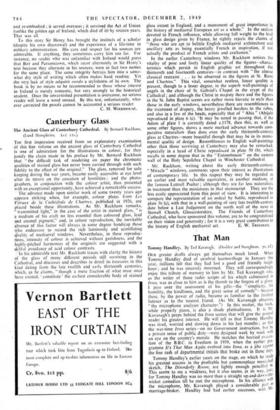Canterbury Glass
The Ancient Glass of Canterbury Cathedral. By Bernard Rackham. (Lund Humphries. Li 2 I 2s.)
THE first impression received from an exploratory examination of this fine volume on the ancient glass of Canterbury Cathedral is one of admiration for the illustrations in colour, for they justify the claim made in his preface by Mr. Bernard Rackham that "the difficult task of rendering on paper the chromatic qualities of stained glass has never been carried through with such fidelity to the effect of the original." The glass, removed for safe keeping during the war years, became easily accessible at eye level after its return on the cessation of hostilities ; and the photo- graphers, in conjunction with the colour artist, thus presented with an exceptional opportunity, have achieved a remarkable success.
The advance made upon similar work of some twenty years ago appears striking when, for example, colour plates from Les Vitraux de la Cathedrale de Chartres, published in 1926, are placed beside these illustrations. As Mr. Rackham remarks, " transmitted light," in the case of the artist in stained glass, " is a medium of his craft no less essential than coloured glass, lead 4nd enamel pigment," and, in colour reproduction, the inevitable absence bf this factor will always in some degree handicap those Who endeavour to record the rich luminosity and scintillating (bath), of mediaeval windows. Nevertheless, in these reproduc- tions, intensity of colour is achieved without garishness, and the highly-pitched harmonies of the originals are suggested with a skilful avoidance of acid colour contrasts.
In his admirable text Mr. Rackham traces with clarity the history of the glass of many different periods still surviving in the Cathedral, and discusses and describes in detail its treasures in this kind dating from the late twelfth and early thirteenth centuries, which, as he claims, " though a mere fraction of what must once have existed, ' constitute' the earliest considerable body of stained glass extant in England, and a monument of great importance in the history of mediaeval European art as a whole." In the section devoted to French influence, while allowing full weight to the lead in glass design given by France, he rightly rejects the claims of " those who are apt to belittle English mediaeval architecture and ancillary arts as being essentially French in inspiration, if not actually the product of French artists and craftsmen."
In the earlier Canterbury windows Mr. Rackham notices the vitality of pose and lively linear quality of the figures—charac- teristics which persist in English graphic art throughout the thirteenth and fourteenth centuries—in contrast with " the almost classical restraint . . . to be observed in the figures at St. Remi and Chartres." This vital, somewhat restless, linear quality is present, though to a lesser degree, in the superb wall-paintings of angels in the choir of St. Gabriel's Chapel in the crypt of the Cathedral; and although the Christ in majesty there and the figures in the St. John Baptist scenes are rather more hieratic in style than those in the early windows, nevertheless there are resemblances in the treatment of drapery, the heavy jewelled borders to the robes, and also in a few of the heads, especially that of " Abia " (Abijain reproduced in plate 6 (c). 'it may be noted in passing that, if the Adam of plate 1 is correctly dated c.I178, then this, as well as some other figures, shows a more marked advance towards com- parative naturalism than does even the early thirteenth-century glass at Chartres—more beautiful though that may be in its monu- mental quality of design. Resemblances to English wall-paintings other than those 'surviving at Canterbury may also be remarked. especially in a head of Christ reproduced in plate 50 (b), which recalls in some degree that in the "Entombment " on the eastern wall of the Holy Sepulchre Chapel in Winchester Cathedral.
Mr. Rackham, writing about the early thirteenth-century " Miracle" windows, comments upon their interest, as illustrations of contemporary life. In this respect they may be regarded as an earlier and most valuable equivalent, in another medium, of the famous Luttrell Psalter ; although they are far less naturalistic in treatment than the miniatures in that manuscript They are the less easily appreciated from this point of view. It is interesting to compare the representation of an ordeal by battle, reproduced in plate 36 (c), with that in a wall-painting of very late twelfth-century date below a Last Judgement on the north wall of the nave in Stowell Church, Gloucestershire. The Friends of Canterbury Cathedral, who have sponsored this volume, are to be congratulated on their vision and generosity ; for it is a very great contribution to the history of English mediaeval art. E. W. TRISTRAM.


































 Previous page
Previous page